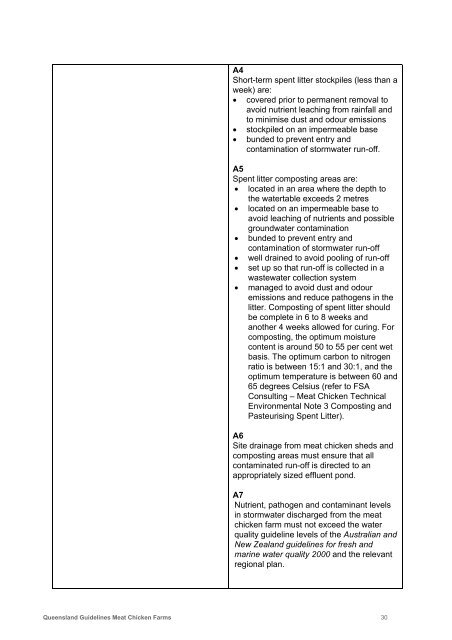Queensland Guidelines: Meat Chicken Farms - Department of ...
Queensland Guidelines: Meat Chicken Farms - Department of ...
Queensland Guidelines: Meat Chicken Farms - Department of ...
You also want an ePaper? Increase the reach of your titles
YUMPU automatically turns print PDFs into web optimized ePapers that Google loves.
A4<br />
Short-term spent litter stockpiles (less than a<br />
week) are:<br />
covered prior to permanent removal to<br />
avoid nutrient leaching from rainfall and<br />
to minimise dust and odour emissions<br />
<br />
<br />
stockpiled on an impermeable base<br />
bunded to prevent entry and<br />
contamination <strong>of</strong> stormwater run-<strong>of</strong>f.<br />
A5<br />
Spent litter composting areas are:<br />
located in an area where the depth to<br />
the watertable exceeds 2 metres<br />
located on an impermeable base to<br />
avoid leaching <strong>of</strong> nutrients and possible<br />
groundwater contamination<br />
bunded to prevent entry and<br />
contamination <strong>of</strong> stormwater run-<strong>of</strong>f<br />
well drained to avoid pooling <strong>of</strong> run-<strong>of</strong>f<br />
set up so that run-<strong>of</strong>f is collected in a<br />
wastewater collection system<br />
managed to avoid dust and odour<br />
emissions and reduce pathogens in the<br />
litter. Composting <strong>of</strong> spent litter should<br />
be complete in 6 to 8 weeks and<br />
another 4 weeks allowed for curing. For<br />
composting, the optimum moisture<br />
content is around 50 to 55 per cent wet<br />
basis. The optimum carbon to nitrogen<br />
ratio is between 15:1 and 30:1, and the<br />
optimum temperature is between 60 and<br />
65 degrees Celsius (refer to FSA<br />
Consulting – <strong>Meat</strong> <strong>Chicken</strong> Technical<br />
Environmental Note 3 Composting and<br />
Pasteurising Spent Litter).<br />
A6<br />
Site drainage from meat chicken sheds and<br />
composting areas must ensure that all<br />
contaminated run-<strong>of</strong>f is directed to an<br />
appropriately sized effluent pond.<br />
A7<br />
Nutrient, pathogen and contaminant levels<br />
in stormwater discharged from the meat<br />
chicken farm must not exceed the water<br />
quality guideline levels <strong>of</strong> the Australian and<br />
New Zealand guidelines for fresh and<br />
marine water quality 2000 and the relevant<br />
regional plan.<br />
<strong>Queensland</strong> <strong>Guidelines</strong> <strong>Meat</strong> <strong>Chicken</strong> <strong>Farms</strong> 30
















